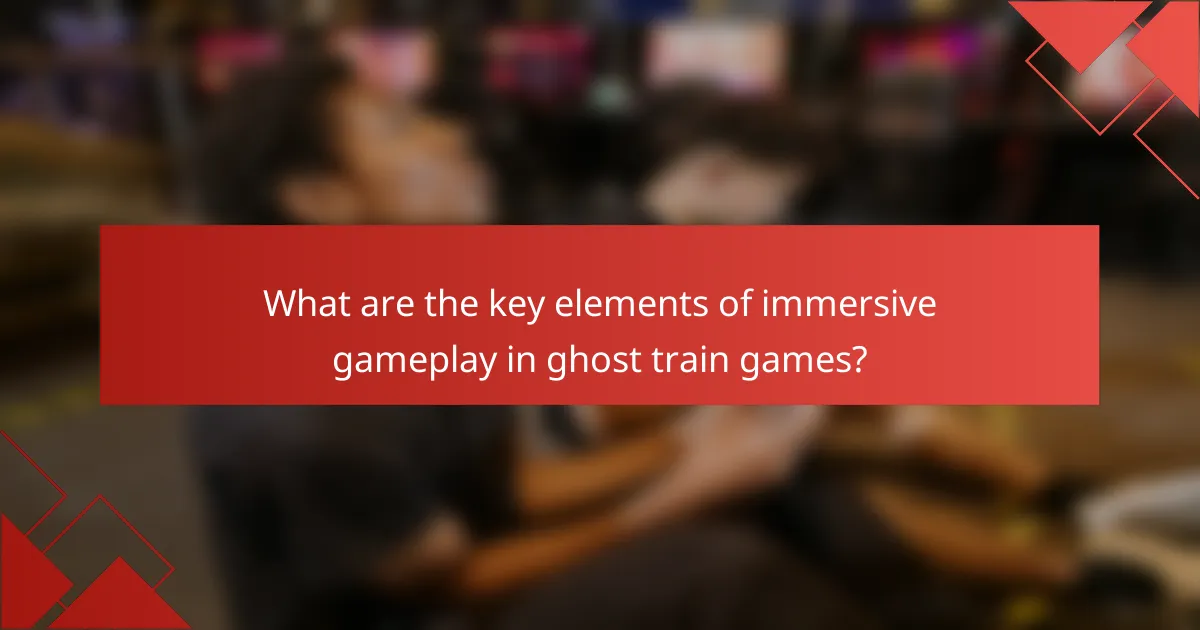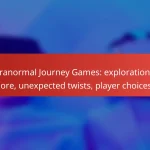Realistic ghost train games offer players a unique blend of authentic settings, historical accuracy, and immersive storytelling. By transporting players to eerie environments filled with rich narratives, these games create compelling experiences that engage and thrill. The attention to detail in both the environmental design and the interactive elements enhances the overall immersion, making players feel deeply connected to the unfolding drama.

What are the best realistic ghost train games available?
The best realistic ghost train games combine authentic settings, historical accuracy, and immersive storytelling to create engaging experiences. These games often transport players to eerie environments filled with rich narratives and chilling encounters.
Ghost Train: The Haunted Experience
Ghost Train: The Haunted Experience offers players a spine-tingling ride through a haunted railway. The game features meticulously designed environments that reflect classic ghost stories, enhancing the sense of dread and excitement. Players can explore abandoned stations and interact with ghostly apparitions, making for a truly immersive experience.
Key elements include atmospheric sound design and visual effects that create a haunting ambiance. Players should pay attention to the storyline, as uncovering the mysteries behind the hauntings is crucial for progressing through the game.
Dark Ride: The Ghost Train Adventure
Dark Ride: The Ghost Train Adventure is a thrilling journey that combines elements of horror and adventure. Players navigate through dark tunnels filled with supernatural entities, each with its unique backstory. The game emphasizes exploration and puzzle-solving, requiring players to think critically to escape the clutches of the unknown.
With its engaging narrative and interactive gameplay, Dark Ride encourages players to uncover hidden secrets while battling their fears. The visual style is reminiscent of classic horror films, adding to the overall experience.
Phantom Express: A Historical Journey
Phantom Express: A Historical Journey takes players on a ride through time, blending historical events with ghostly encounters. The game is set in various historical periods, allowing players to experience the past while facing supernatural challenges. This unique approach not only entertains but also educates players about different eras.
Players should focus on the historical context provided in the game, as it enriches the storytelling. Engaging with the lore can lead to discovering hidden paths and unlocking special content.
Ghost Train Simulator: Realistic Scenarios
Ghost Train Simulator: Realistic Scenarios offers a unique blend of simulation and horror. Players take on the role of a train conductor navigating through haunted landscapes, where they must manage both the train and the eerie occurrences around them. The game emphasizes realism, with detailed train mechanics and environmental interactions.
To succeed, players need to balance operational tasks with the supernatural elements that threaten their journey. Familiarizing oneself with the controls and understanding the game’s mechanics can significantly enhance the overall experience.

How do realistic ghost train games enhance storytelling?
Realistic ghost train games enhance storytelling by immersing players in authentic settings and narratives that reflect historical accuracy. This combination creates a compelling experience that draws players into the story, making them feel part of the unfolding drama.
Immersive narratives through historical accuracy
Historical accuracy in ghost train games provides a rich backdrop that enhances immersion. By incorporating real events, locations, and cultural elements, these games create a believable world that players can explore. For instance, a game set in a Victorian-era train station might include period-appropriate architecture and social customs, making the experience more engaging.
Players often connect more deeply with narratives that resonate with actual history. This connection can evoke emotions and provoke thought about the past, allowing players to reflect on the stories of those who lived before them. Games that effectively weave historical details into their plots can significantly elevate the storytelling experience.
Character-driven experiences in gameplay
Character-driven experiences are central to the storytelling in ghost train games. Players often take on roles of characters with rich backstories, motivations, and emotional arcs. This focus on character development allows players to form attachments and invest in the outcomes of their journeys.
Effective character design can include diverse personalities and complex relationships, which enrich the narrative. For example, a game might feature a ghostly conductor seeking redemption or a passenger uncovering dark secrets. These character dynamics not only propel the plot but also encourage players to engage with the story on a personal level, enhancing the overall experience.

What features define authentic ghost train game settings?
Authentic ghost train game settings are characterized by realistic environmental design, attention to historical details, and interactive storytelling elements. These features work together to create an immersive experience that transports players into a world that feels genuine and engaging.
Realistic environmental design
Realistic environmental design in ghost train games involves creating visually compelling and believable settings that reflect the eerie atmosphere typical of haunted locations. This includes using detailed textures, appropriate lighting, and sound effects that evoke a sense of dread or mystery.
For instance, a ghost train game might feature dilapidated train stations, foggy landscapes, and overgrown tracks. These elements should be carefully crafted to enhance the overall experience, making players feel as though they are truly navigating through a haunted environment.
Attention to historical details
Attention to historical details is crucial for grounding the game in a believable context. This means incorporating accurate representations of the time period, including architecture, clothing, and social customs relevant to the ghost train’s backstory.
For example, if a game is set in the early 1900s, the design should reflect the technology and aesthetics of that era. Researching local history can provide valuable insights that enhance authenticity and deepen players’ connection to the narrative.
Interactive storytelling elements
Interactive storytelling elements allow players to engage with the narrative actively, making choices that influence the outcome of the game. This can include branching dialogue options, puzzles that reveal backstory, or environmental clues that players can discover as they progress.
Incorporating these elements not only enriches the gameplay but also encourages players to explore the setting more thoroughly. For instance, players might find diary entries or artifacts that provide context about the hauntings, creating a more layered and immersive storytelling experience.

How do developers ensure historical accuracy in ghost train games?
Developers ensure historical accuracy in ghost train games by conducting thorough research and collaborating with experts in local history and folklore. This process involves integrating authentic narratives and settings that resonate with players, enhancing the immersive experience.
Researching local folklore and history
To create a believable ghost train game, developers delve into the rich tapestry of local folklore and historical events. They explore legends, myths, and significant occurrences that shape the cultural identity of the area. This research helps in crafting storylines that are not only engaging but also rooted in the community’s heritage.
For instance, a game set in a region known for its haunted railroads might incorporate tales of ghostly passengers or tragic accidents that occurred on those very tracks. By weaving these elements into the gameplay, developers can create a more authentic and captivating experience for players.
Consulting historians and cultural experts
Engaging with historians and cultural experts is crucial for ensuring the accuracy of the game’s content. These professionals provide insights into the historical context, helping developers avoid common pitfalls and inaccuracies. Their expertise can guide the portrayal of events, characters, and settings, ensuring they reflect the true essence of the time period.
For example, a historian might advise on the architectural styles of train stations from a specific era, influencing the game’s visual design. By collaborating with these experts, developers can enhance the credibility of their narratives and foster a deeper connection with players who appreciate historical authenticity.

What are the key elements of immersive gameplay in ghost train games?
Immersive gameplay in ghost train games relies on authentic settings, historical accuracy, and compelling storytelling. These elements work together to create a captivating experience that draws players into the eerie world of ghost trains.
Engaging sound design and music
Sound design and music are crucial for creating an immersive atmosphere in ghost train games. High-quality audio effects, such as creaking tracks, distant whispers, and haunting melodies, enhance the player’s emotional engagement and sense of realism.
Consider using layered soundscapes that evolve as players progress through the game. For example, starting with subtle background noises that gradually intensify can build tension and anticipation. Avoid overly repetitive sounds to maintain immersion.
Dynamic lighting and visual effects
Dynamic lighting and visual effects significantly contribute to the eerie ambiance of ghost train games. Utilizing shadows, flickering lights, and sudden visual changes can create a sense of unease and surprise, keeping players on edge.
Incorporating realistic weather effects, such as fog or rain, can further enhance the atmosphere. Ensure that visual elements are consistent with the game’s historical context to maintain authenticity. Avoid cluttered visuals that may distract from the core experience.

What are the challenges in creating ghost train games?
Creating ghost train games involves navigating the complexities of historical accuracy, immersive storytelling, and engaging gameplay. Developers must balance these elements to deliver a compelling experience that resonates with players while remaining true to the ghost train theme.
Balancing realism with entertainment
Achieving a balance between realism and entertainment is crucial in ghost train games. While players appreciate authentic settings and historical details, they also seek engaging gameplay that keeps them entertained. Developers should incorporate real-life ghost stories and local legends to enhance authenticity while ensuring that gameplay mechanics remain fun and accessible.
For example, integrating puzzles based on historical events or local folklore can provide depth without sacrificing enjoyment. Developers should focus on creating a narrative that captivates players while allowing for creative liberties that enhance the gaming experience.
Technical limitations in game design
Technical limitations can significantly impact the creation of ghost train games. Developers must consider the capabilities of the target platforms, including graphics rendering, sound design, and interactive elements. High-quality graphics and immersive audio are essential for creating an authentic atmosphere, but they require powerful hardware.
Additionally, the complexity of historical settings may lead to performance issues if not optimized properly. Developers should prioritize essential features and streamline content to ensure smooth gameplay. Regular testing and feedback from players can help identify technical challenges early in the development process, allowing for timely adjustments.

How can players experience ghost train games in major cities?
Players can immerse themselves in ghost train games by participating in local events, exploring themed attractions, or engaging in virtual reality experiences. These activities often combine historical elements with storytelling to create an authentic atmosphere that enhances the thrill of the ghost train concept.
Local ghost train events in New Orleans
New Orleans hosts several ghost train events that blend the city’s rich history with supernatural storytelling. The Haunted Ghost Train, for instance, offers guided tours that take participants through eerie locations while sharing local legends and ghost stories.
These events typically run during the Halloween season but may also occur year-round. Participants should check local listings for specific dates and ticket prices, which generally range from $20 to $50 per person.
Virtual reality experiences in London
London features innovative virtual reality experiences that transport players into haunted train scenarios. These VR games often utilize cutting-edge technology to create immersive environments where players can interact with ghostly figures and solve mysteries.
Popular venues like the London Dungeon offer VR experiences that include ghost train themes, allowing players to feel the thrill of the supernatural. Tickets for these experiences usually range from £25 to £60, depending on the package and duration of the experience.


